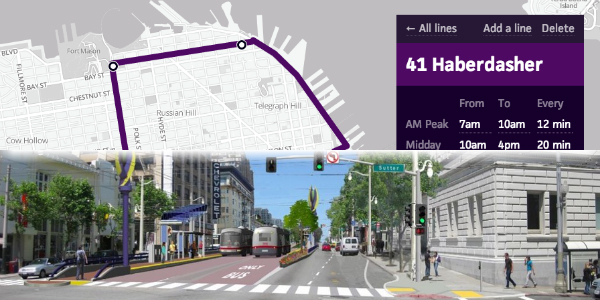
(Screenshot of TransitMix app (top); Bus line rendering via SFMTA)
Technology has become a way of life for most Americans, not just for communication but also for many daily activities. However, there’s more that can be done than just booking a trip or crushing candy. With a majority of Americans now owning smartphones, it’s only becoming more obvious that there’s room for governments to engage the public and provide more bang for their buck via technology.
CA Fwd has been putting on an “Open Data roadshow” around the state to highlight ways the marriage of tech and info can make government more efficient and transparent.
Jurisdictions have also been discovering that using technology and smartphone apps can be beneficial in the pursuit of improving infrastructure. Saving any amount of money on such projects is especially important for California, where it’s been estimated the state will only have half of the $765 billion needed for infrastructure investments over the next decade.
One of the best examples of applying technology to infrastructure problems comes from South Carolina, where an innovative bridge-monitoring system is producing real savings, despite being in use on only eight bridges.
Girder sensors are placed on each bridge so that they can measure its carrying capacity and can be monitored 24/7. Although, the monitors don’t eliminate the need for inspections, the technology does make the need for them significantly less frequent. Data from the monitors also led the South Carolina Department of Transportation to correct one bridge’s problems with a $100,000 retrofit, rather than spending $800,000 to replace it.
In total, having the monitors on just eight bridges, at a cost of about $50,000 per bridge, saved taxpayers $5 million.
That kind of innovation and savings is exactly what California needs to ensure that infrastructure projects happen in a more timely and efficient fashion in the future. It’s also what is driving civic innovators to bring together technology and crowdsourcing and make sure infrastructure projects also are results oriented.
“California has a lot of people and technology can really help even things out when they’re allowed to come together and share information that can improve an area,” said Code for America’s (CfA) Lyzi Diamond. “Being able to work collaboratively to enhance infrastructure creation is a big part of an application’s usefulness.”
Diamond, who is a 2014 fellow for the San Francisco-based organization, is a member of the CfA team that recently developed the Transitmix app. The transit-planning app allows users to draw their own routes by dragging and dropping points so that they snap to a street grid.
“The reception [to the Transitmix] app has been wonderful; it’s the tool that transit planners have always wanted, but never knew they needed,” said Diamond. “It’s a comprehensive way of the seeing the potential effects of street planning before it happens so that you have a better understanding of what will work.”
The idea is that by engaging people who use public transportation in the route planning process through something as simple as their smartphones, officials will be able to better understand public needs and therefore plan accordingly, instead of wasting money on guessing the best routes.
“We’re in a very different time and by creating applications like [Transitmix], we’ve recognized that efficiency is really key to successful infrastructure execution,” said Diamond. “Tapping into the connection between actual people and planning is how changes will happen.”
As Diamond says, the innovations that are improving infrastructure are growing daily and there’s no better time to put them to use than now.
Cities and states will have to overcome some structural and budget issues to take advantage of new tech. Only two percent of state and local agencies have a complete big data strategy and 25 percent of the average agency’s data is stored in an unstructured form.
Yet, as the South Carolina example and the potential of the TransitMix app show, the return on investment can be great, especially with important issues like the infrastructure that supports California’s economy.

